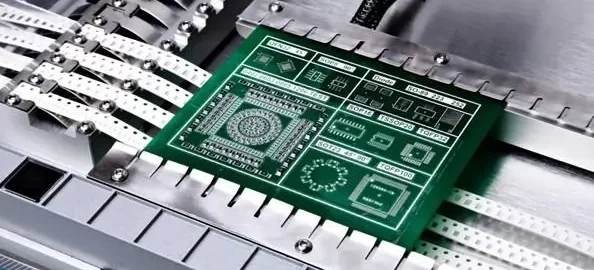SMT assembly process
The SMT assembly process is closely related to each process step before welding, including capital investment, PCB design, component solderability, assembly operations, flux selection, temperature/time control, solder and crystal structure, etc.
1 solder
At present, the most commonly used solder in wave soldering is eutectic tin-lead alloy: 63% tin; 37% lead. The temperature of the solder in the soldering pot should be controlled at all times. The temperature should be 183°C higher than the alloy liquid temperature and the temperature should be uniform. In the past, a solder pot temperature of 250°C was considered the “standard”.
With the innovation of flux technology, the uniformity of solder temperature in the entire solder pot has been controlled, and a preheater has been added. The development trend is to use a lower temperature solder pot. It is common to set the solder pot temperature in the range of 230-240°C. Often, components do not have uniform thermal mass, and it is necessary to ensure that all solder joints reach sufficient temperatures to form qualified solder joints. The important issue is to provide enough heat to raise the temperature of all leads and pads to ensure solder flow and wet both sides of the solder joint. The lower temperature of the solder will reduce the thermal shock to the components and substrate, helping to reduce the formation of dross. At a lower intensity, the flux coating operation and the combined action of the flux compound can make the wave outlet have Enough flux will reduce the generation of burrs and solder balls.
The composition of the solder in the soldering pot is closely related to time, that is, it changes with time, which leads to the formation of dross. This is the reason why residues and other metal impurities must be removed from the welded components and during the welding process. Causes of tin loss. These factors can reduce solder fluidity. During procurement, the maximum limits of metal trace dross and tin content of solder must be specified in various standards (such as IPC/J-STD-006, which has clear regulations). During the welding process, the requirements for solder purity are also specified in the ANSI/J-STD-001B standard. In addition to the restrictions on dross, the minimum tin content in 63% tin and 37% lead alloys must not be less than 61.5%. Gold and organic layer copper concentrations build up faster on wave soldered components than in the past. This buildup, combined with significant tin loss, can cause the solder to lose fluidity and create soldering problems. Rough, grainy solder joints are often caused by dross in the solder. Dark, rough, granular solder joints due to accumulated scum in the solder pot or inherent residue of the component itself may also be a sign of low tin content, either localized specialty solder joints or the result of tin loss in the pot. This appearance may also be caused by vibration or shock during the setting process.
The appearance of solder joints can directly reflect process problems or material problems. It is important to inspect the solder pot analysis in order to maintain a “full pot” condition of solder and in accordance with the process control plan. “Draining” the flux from the solder pot due to scum in the pot is generally unnecessary since conventional applications require that the pot be filled with solder so that the pot is always full. . In the case of tin losses, adding pure tin helps maintain the desired concentration. To monitor the compounds in the tin pot, routine analysis should be performed. If tin is added, samples should be taken and analyzed to ensure the correct proportions of solder ingredients. Excessive scum is another thorny problem. There is no doubt that there is always dross in the soldering pot, especially when soldering in the atmosphere. Using a “chip wave” is helpful when soldering high-density components, which can produce more dross because the solder surface is too large to be exposed to the atmosphere, which oxidizes the solder. The surface of the solder in the soldering pot is covered with a scum layer, and the oxidation rate is slowed down.
In soldering, more dross is produced due to the turbulence and flow of the wave peaks in the tin pot. The recommended general method is to skim off the dross. If skimming is done frequently, more dross will be produced and more solder will be consumed. Dross may also be included in the wave crest, causing instability or turbulence in the wave crest, thus requiring more maintenance of the liquid components in the solder pot. If the amount of solder in the pot is allowed to be reduced, dross on the solder surface will enter the pump, which is likely to occur. Sometimes, granular solder joints can contain dross. The initial scum found may be caused by rough wave crests and may clog the pump. The tin pot should be equipped with an adjustable low-volume solder sensor and alarm device.
2 crest
In the wave soldering process, the wave crest is the core. The preheated, flux-coated, contaminant-free metal can be sent to the welding workstation through a conveyor belt, contacted with solder at a certain temperature, and then heated, so that the flux will react chemically, and the solder alloy will form interconnections through wave crest power. is the most critical step. At present, the commonly used symmetrical wave crest is called the main wave crest, and the pump speed, wave crest height, infiltration depth, transmission angle and transmission speed are set to provide all-round conditions for achieving good welding characteristics. The data should be adjusted appropriately, and the solder operation should be slowed down and stopped slowly after leaving the wave peak (exit end). The PCB runs with the wave crest and eventually pushes the solder to the outlet. In the worst-case scenario, the surface tension of the solder and the crest run of the board are optimized to achieve zero relative motion between the component and the crest at the exit end. This shelling area is used to remove the solder from the board. Sufficient inclination angles should be provided without defects such as bridging, burrs, wire drawing and solder balls. Sometimes it is necessary to have a hot air flow at the crest outlet to ensure that possible bridging is eliminated. After mounting surface mount components on the bottom of the board, turbulent chip waveforms are sometimes used to compensate for the flux or bubbles forming in the “harsh wave” area behind the waveform before performing wave flattening. The high vertical velocity of the turbulent wave crest helps ensure solder contact with the lead or pad. The vibrating section behind the flattened laminar flow peaks can also be used to eliminate air bubbles and ensure satisfactory solder contact to the component. The welding workstation should basically achieve: high-purity solder (according to standards), wave peak temperature (230~250℃), total time of contact with the wave peak (3~5 seconds), and the depth of the printed board immersed in the wave peak (50~80 %), to achieve parallel transmission tracks and the flux content in the tin pot when the wave peak is parallel to the track.
3 Cooling after wave soldering
A cooling workstation is usually added to the tail of the wave soldering machine. The purpose is to limit the tendency of copper-tin intermetallic compounds to form solder joints. Another reason is to accelerate the cooling of the components and prevent the board from shifting when the solder is not completely solidified. Rapidly cools components to limit exposure of sensitive components to high temperatures. However, the hazards of thermal shock to components and solder joints from aggressive cooling systems should be considered. A well-controlled, “soft and steady”, forced gas cooling system should not damage most components. There are two reasons for using this system: to be able to quickly handle the plates without holding them by hand, and to keep the components cooler than the cleaning solution. The concern is with the latter cause, which may be responsible for the bubbling of some flux residues. Another phenomenon is that it sometimes reacts with certain flux scum, making the residue “impossible to clean”. No formula can meet these requirements in terms of ensuring that the data set up in the welding workstation meets all machines, all designs, all materials used and process material conditions and requirements. Every step of the process must be understood.
4 Conclusion
In short, in order to obtain the best welding quality and meet the needs of users, every process step before and during welding must be controlled, because every step of the entire SMT assembly process is interrelated and interacts with each other. If there is a problem in any step, it will In-film to overall reliability and quality. The same is true for soldering operations, so all parameters, time/temperature, solder volume, flux composition, transfer speed, etc. should be strictly controlled. For defects generated during welding, the causes should be identified as early as possible, analyzed, and corresponding measures should be taken to nip various defects that affect quality in the bud. In this way, we can ensure that the products produced meet the technical specifications.
Send us an inquiry , we will get back to you soon ,thank you!

